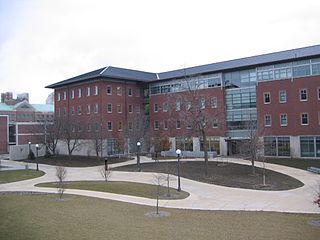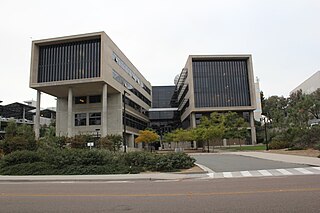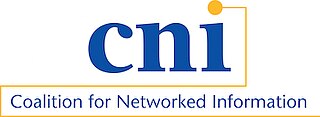
The National Center for Supercomputing Applications (NCSA) is a state-federal partnership to develop and deploy national-scale cyberinfrastructure that advances research, science and engineering based in the United States. NCSA operates as a unit of the University of Illinois Urbana-Champaign, and provides high-performance computing resources to researchers across the country. Support for NCSA comes from the National Science Foundation, the state of Illinois, the University of Illinois, business and industry partners, and other federal agencies.

The Cornell University Center for Advanced Computing (CAC), housed at Frank H. T. Rhodes Hall on the campus of Cornell University, is one of five original centers in the National Science Foundation's Supercomputer Centers Program. It was formerly called the Cornell Theory Center.

Internet2 is a not-for-profit United States computer networking consortium led by members from the research and education communities, industry, and government. The Internet2 consortium administrative headquarters are located in Ann Arbor, Michigan, with offices in Washington, D.C., and Emeryville, California.

The San Diego Supercomputer Center (SDSC) is an organized research unit of the University of California, San Diego (UCSD). SDSC is located at the UCSD campus' Eleanor Roosevelt College east end, immediately north the Hopkins Parking Structure.
United States federal research funders use the term cyberinfrastructure to describe research environments that support advanced data acquisition, data storage, data management, data integration, data mining, data visualization and other computing and information processing services distributed over the Internet beyond the scope of a single institution. In scientific usage, cyberinfrastructure is a technological and sociological solution to the problem of efficiently connecting laboratories, data, computers, and people with the goal of enabling derivation of novel scientific theories and knowledge.

TeraGrid was an e-Science grid computing infrastructure combining resources at eleven partner sites. The project started in 2001 and operated from 2004 through 2011.

RedCLARA: the Latin American space for collaboration and development in education, science and innovation
The Corporation for Education Network Initiatives in California is a nonprofit corporation formed in 1997 to provide high-performance, high-bandwidth networking services to California universities and research institutions. Through this corporation, representatives from all of California's K-20 public education combine their networking resources toward the operation, deployment, and maintenance of the California Research and Education Network, or CalREN. Today, CalREN operates over 8,000 miles of fiber optic cable and serves more than 20 million users.
Educause is a nonprofit association in the United States whose mission is "to advance higher education through the use of information technology". Membership is open to institutions of higher education, corporations serving the higher education information technology market, and other related associations and organizations.

The Energy Sciences Network (ESnet) is a high-speed computer network serving United States Department of Energy (DOE) scientists and their collaborators worldwide. It is managed by staff at the Lawrence Berkeley National Laboratory.
The term e-Research refers to the use of information technology to support existing and new forms of research. This extends cyber-infrastructure practices established in STEM fields such as e-Science to cover other all research areas, including HASS fields such as digital humanities.

John C. Klensin is a political scientist and computer science professional who is active in Internet-related issues.

nanoHUB.org is a science and engineering gateway comprising community-contributed resources and geared toward education, professional networking, and interactive simulation tools for nanotechnology. Funded by the United States National Science Foundation (NSF), it is a product of the Network for Computational Nanotechnology (NCN). NCN supports research efforts in nanoelectronics; nanomaterials; nanoelectromechanical systems (NEMS); nanofluidics; nanomedicine, nanobiology; and nanophotonics.
CAMERA, or the Community Cyberinfrastructure for Advanced Microbial Ecology Research and Analysis, is an online cloud computing service that provides hosted software tools and a high-performance computing infrastructure for the analysis of metagenomic data. The project was announced in January 2006, becoming Calit2's flagship project.

Stephen South Wolff is one of the many fathers of the Internet. He is mainly credited with turning the Internet from a government project into something that proved to have scholarly and commercial interest for the rest of the world. Dr. Wolff realized before most the potential in the Internet and began selling the idea that the Internet could have a profound effect on both the commercial and academic world.

The Coalition for Networked Information (CNI) is an organization whose mission is to promote networked information technology as a way to further the advancement of intellectual collaboration and productivity.

The iPlant Collaborative, renamed Cyverse in 2017, is a virtual organization created by a cooperative agreement funded by the US National Science Foundation (NSF) to create cyberinfrastructure for the plant sciences (botany). The NSF compared cyberinfrastructure to physical infrastructure, "... the distributed computer, information and communication technologies combined with the personnel and integrating components that provide a long-term platform to empower the modern scientific research endeavor". In September 2013 it was announced that the National Science Foundation had renewed iPlant's funding for a second 5-year term with an expansion of scope to all non-human life science research.

Doug Gale was an early developer of the Internet. Gale earned a Ph.D. in physics from Kansas State University in 1972, and served as a tenured associate professor of physics at East Texas State University for eight years, during which time his research interests shifted to computer science.

Doug Van Houweling is a professor at the University of Michigan School of Information. He is best known for his contributions to the development and deployment of the Internet. For these accomplishments, he was inducted into the Internet Hall of Fame in 2014. He is also the recipient of the EDUCAUSE 2002 Excellence in Leadership Award, the Iowa State University John V. Atanasoff Discovery Award, the Indiana University Thomas Hart Benton Mural Medallion, and an honorary Doctor of Science from Indiana University in May, 2017. Van Houweling was the Associate Dean for Research and Innovation from 2010 to 2014. Prior to that, he was the Dean for Academic Outreach and Vice Provost for Information technology at the University of Michigan.














